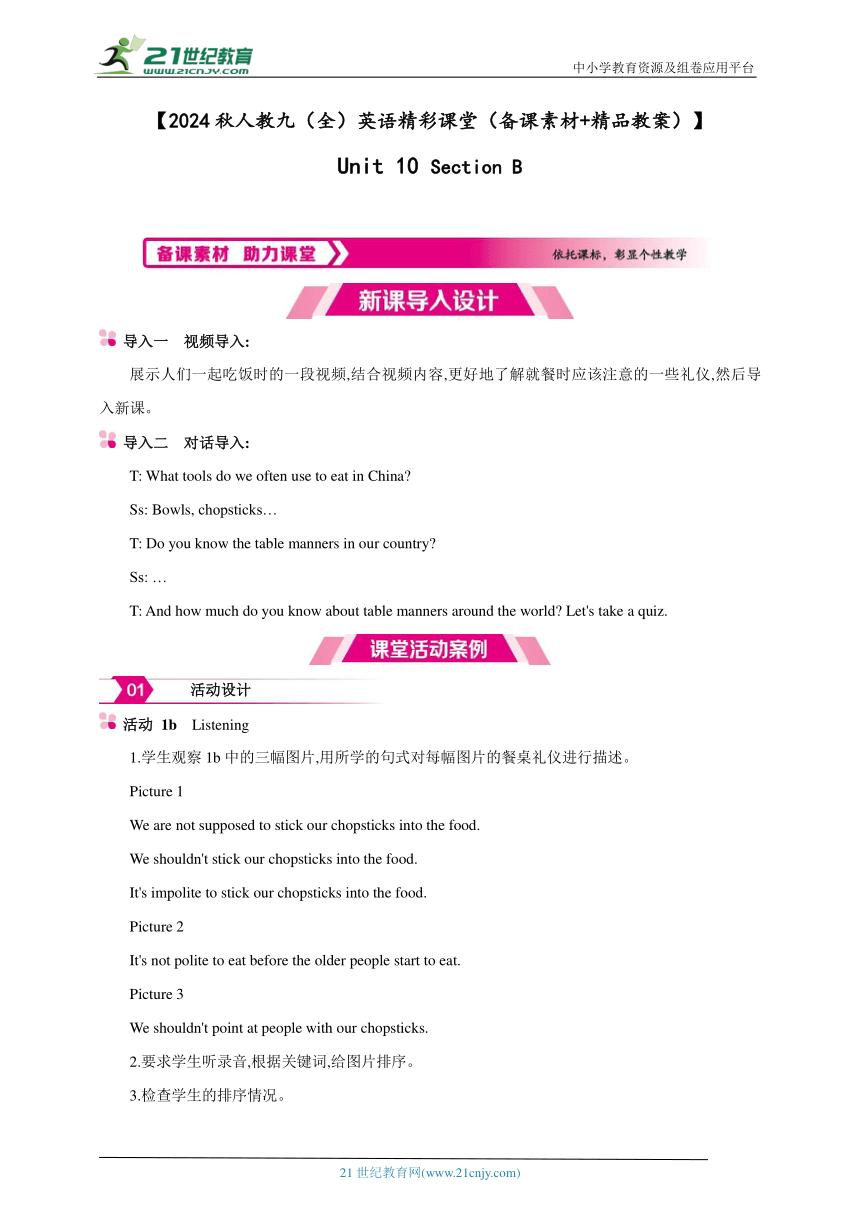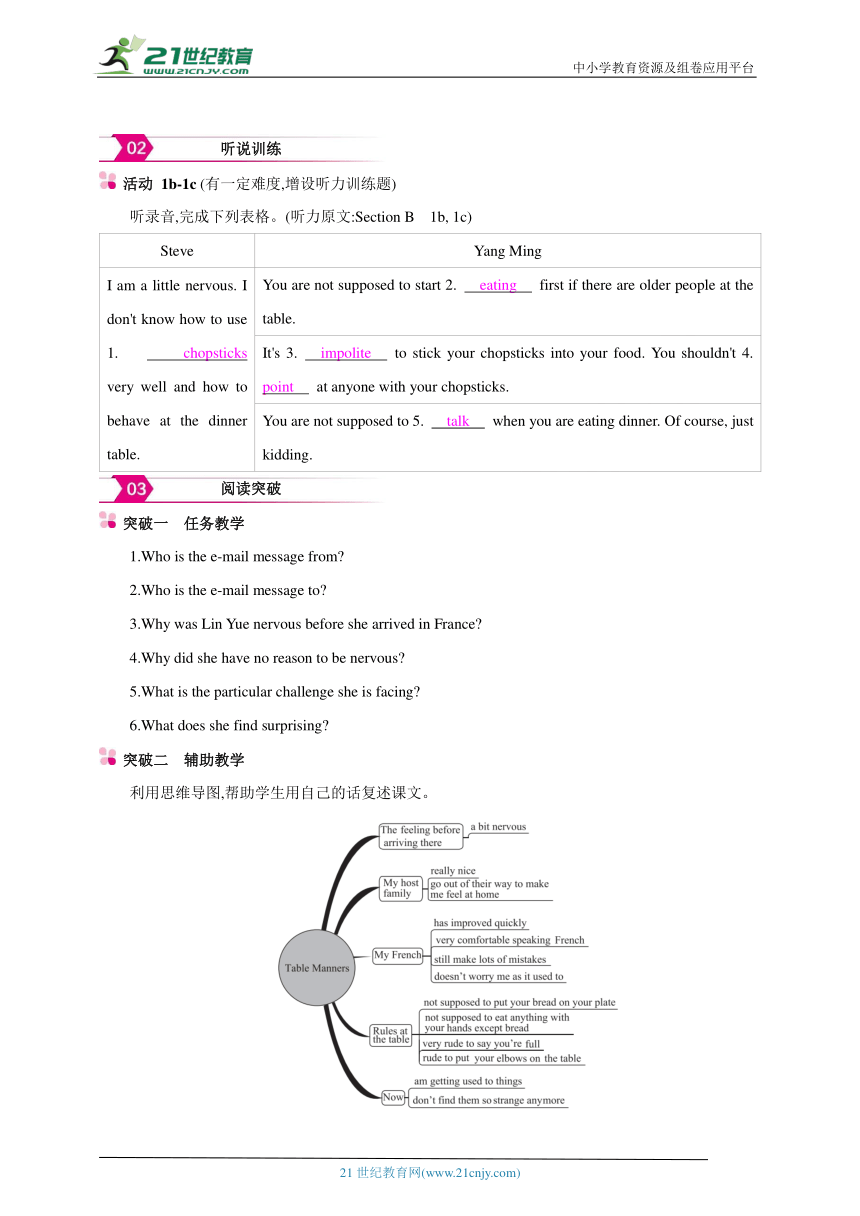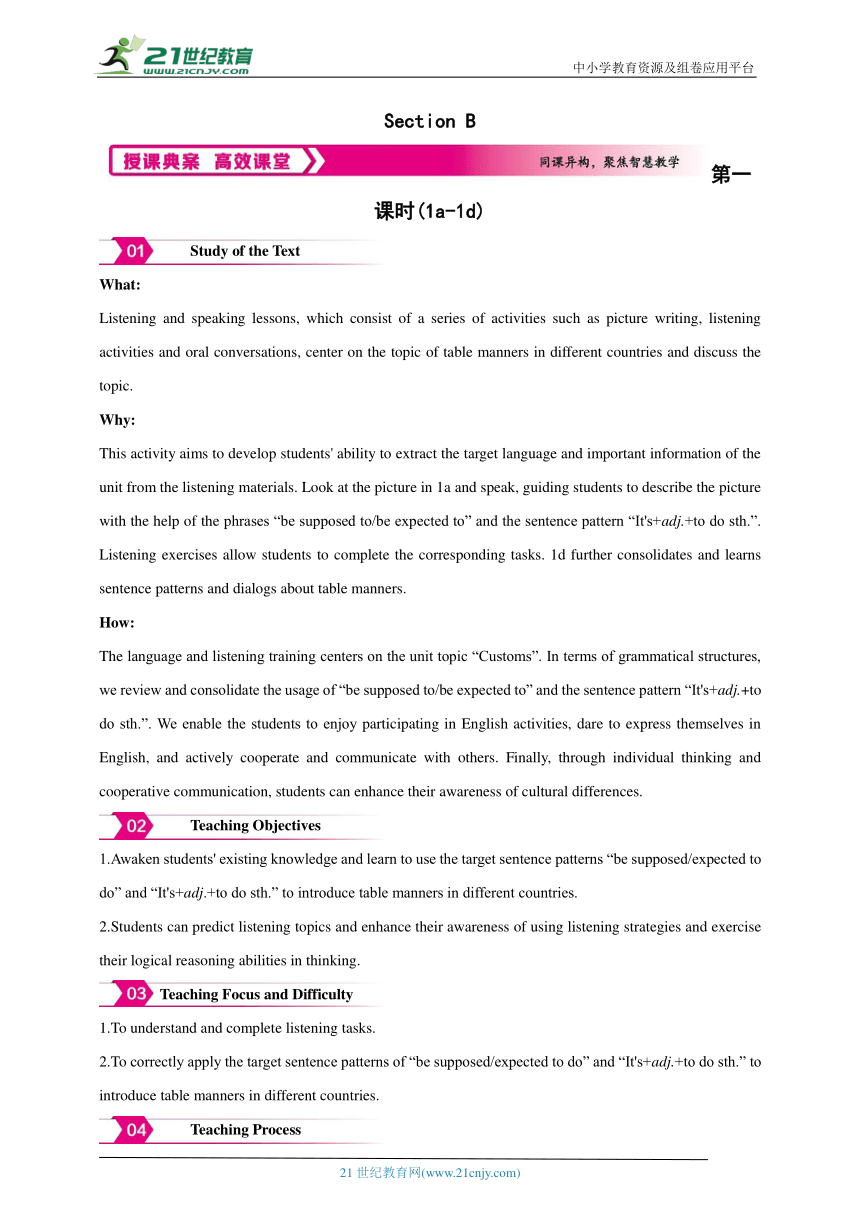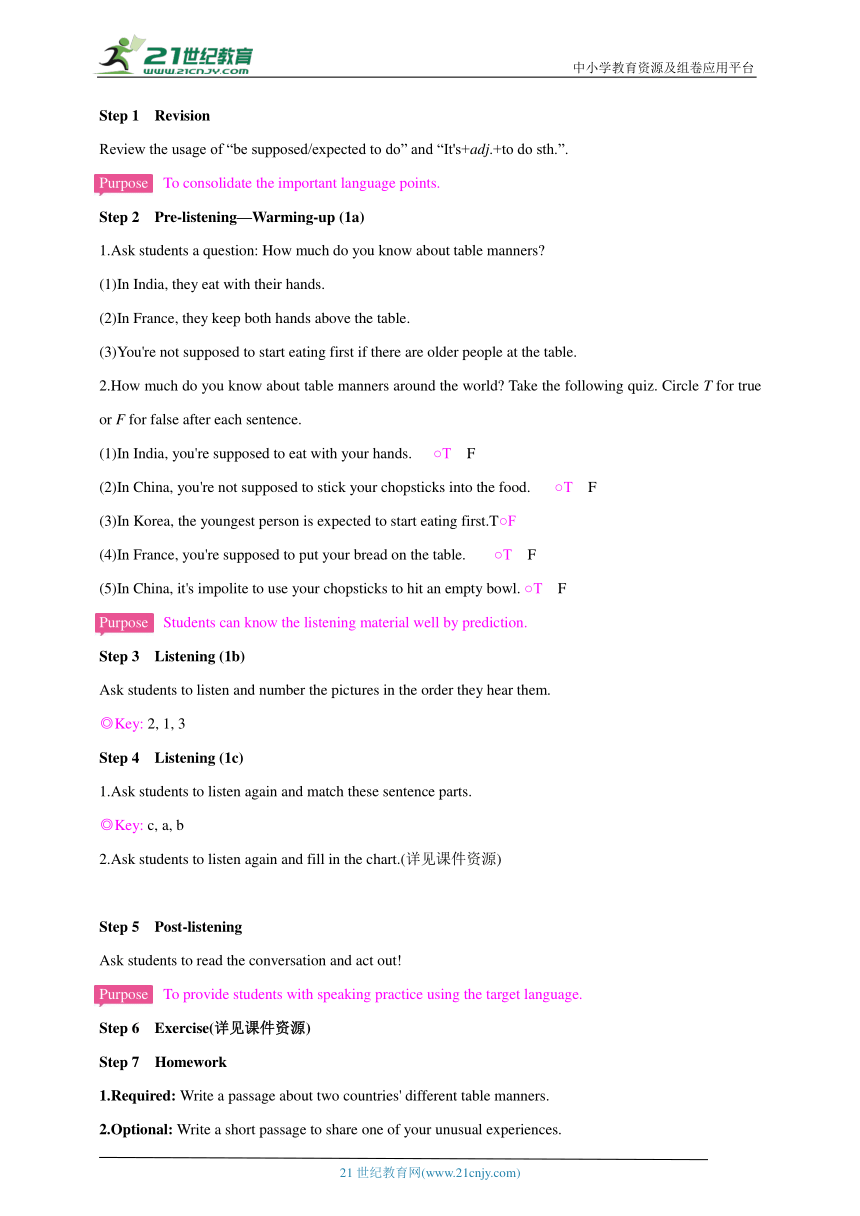【2024秋人教九(全)英语精彩课堂(备课素材+精品教案)】Unit 10 section B
文档属性
| 名称 | 【2024秋人教九(全)英语精彩课堂(备课素材+精品教案)】Unit 10 section B |  | |
| 格式 | docx | ||
| 文件大小 | 576.9KB | ||
| 资源类型 | 试卷 | ||
| 版本资源 | 人教新目标(Go for it)版 | ||
| 科目 | 英语 | ||
| 更新时间 | 2024-11-12 14:58:18 | ||
图片预览




文档简介
中小学教育资源及组卷应用平台
【2024秋人教九(全)英语精彩课堂(备课素材+精品教案)】
Unit 10 Section B
导入一 视频导入:
展示人们一起吃饭时的一段视频,结合视频内容,更好地了解就餐时应该注意的一些礼仪,然后导入新课。
导入二 对话导入:
T: What tools do we often use to eat in China
Ss: Bowls, chopsticks…
T: Do you know the table manners in our country
Ss: …
T: And how much do you know about table manners around the world Let's take a quiz.
活动设计
活动 1b Listening
1.学生观察1b中的三幅图片,用所学的句式对每幅图片的餐桌礼仪进行描述。
Picture 1
We are not supposed to stick our chopsticks into the food.
We shouldn't stick our chopsticks into the food.
It's impolite to stick our chopsticks into the food.
Picture 2
It's not polite to eat before the older people start to eat.
Picture 3
We shouldn't point at people with our chopsticks.
2.要求学生听录音,根据关键词,给图片排序。
3.检查学生的排序情况。
听说训练
活动 1b-1c (有一定难度,增设听力训练题)
听录音,完成下列表格。(听力原文:Section B 1b, 1c)
Steve Yang Ming
I am a little nervous. I don't know how to use 1. chopsticks very well and how to behave at the dinner table. You are not supposed to start 2. eating first if there are older people at the table.
It's 3. impolite to stick your chopsticks into your food. You shouldn't 4. point at anyone with your chopsticks.
You are not supposed to 5. talk when you are eating dinner. Of course, just kidding.
阅读突破
突破一 任务教学
1.Who is the e-mail message from
2.Who is the e-mail message to
3.Why was Lin Yue nervous before she arrived in France
4.Why did she have no reason to be nervous
5.What is the particular challenge she is facing
6.What does she find surprising
突破二 辅助教学
利用思维导图,帮助学生用自己的话复述课文。
Section B
第一课时(1a-1d)
Study of the Text
What:
Listening and speaking lessons, which consist of a series of activities such as picture writing, listening activities and oral conversations, center on the topic of table manners in different countries and discuss the topic.
Why:
This activity aims to develop students' ability to extract the target language and important information of the unit from the listening materials. Look at the picture in 1a and speak, guiding students to describe the picture with the help of the phrases “be supposed to/be expected to” and the sentence pattern “It's+adj.+to do sth.”. Listening exercises allow students to complete the corresponding tasks. 1d further consolidates and learns sentence patterns and dialogs about table manners.
How:
The language and listening training centers on the unit topic “Customs”. In terms of grammatical structures, we review and consolidate the usage of “be supposed to/be expected to” and the sentence pattern “It's+adj.+to do sth.”. We enable the students to enjoy participating in English activities, dare to express themselves in English, and actively cooperate and communicate with others. Finally, through individual thinking and cooperative communication, students can enhance their awareness of cultural differences.
Teaching Objectives
1.Awaken students' existing knowledge and learn to use the target sentence patterns “be supposed/expected to do” and “It's+adj.+to do sth.” to introduce table manners in different countries.
2.Students can predict listening topics and enhance their awareness of using listening strategies and exercise their logical reasoning abilities in thinking.
Teaching Focus and Difficulty
1.To understand and complete listening tasks.
2.To correctly apply the target sentence patterns of “be supposed/expected to do” and “It's+adj.+to do sth.” to introduce table manners in different countries.
Teaching Process
Step 1 Revision
Review the usage of “be supposed/expected to do” and “It's+adj.+to do sth.”.
Purpose To consolidate the important language points.
Step 2 Pre-listening—Warming-up (1a)
1.Ask students a question: How much do you know about table manners
(1)In India, they eat with their hands.
(2)In France, they keep both hands above the table.
(3)You're not supposed to start eating first if there are older people at the table.
2.How much do you know about table manners around the world Take the following quiz. Circle T for true or F for false after each sentence.
(1)In India, you're supposed to eat with your hands. ○T F
(2)In China, you're not supposed to stick your chopsticks into the food. ○T F
(3)In Korea, the youngest person is expected to start eating first.T○F
(4)In France, you're supposed to put your bread on the table. ○T F
(5)In China, it's impolite to use your chopsticks to hit an empty bowl. ○T F
Purpose Students can know the listening material well by prediction.
Step 3 Listening (1b)
Ask students to listen and number the pictures in the order they hear them.
◎Key: 2, 1, 3
Step 4 Listening (1c)
1.Ask students to listen again and match these sentence parts.
◎Key: c, a, b
2.Ask students to listen again and fill in the chart.(详见课件资源)
Step 5 Post-listening
Ask students to read the conversation and act out!
Purpose To provide students with speaking practice using the target language.
Step 6 Exercise(详见课件资源)
Step 7 Homework
1.Required: Write a passage about two countries' different table manners.
2.Optional: Write a short passage to share one of your unusual experiences.
第二课时(2a-2e)
Study of the Text
What:
This is an article about the differences of table manners between France and China.
Why:
2a-2b aim to guide students to think about the customs in foreign countries and the challenges when visiting a foreign country. 2b trains the scanning strategy to obtain key information and further deepens the grasp of the text. 2d is designed to review the passage and make notes about French customs in the chart.2e is a comprehensive approach to reading and writing, which involves extending the training of students' critical thinking abilities to find out more.
How:
Through video and question introduction, attract and organize students to actively participate in reading training. Through prediction, fast reading, and close reading strategies, guide students to observe, think, communicate, cooperate, and complete the tasks of this lesson.
Teaching Objectives
1.Students are able to use the following words to discuss French dining table customs: basic, exchange, teenage, granddaughter, behave, except, elbow, gradually.
2.Students can accurately predict and extract key information, and exercise their logical reasoning ability.
3.Students can use the reading skills to quickly complete the reading and retell the entire article through a mind map.
Teaching Focus and Difficulty
Teaching Focus:
Master new vocabulary and phrases related to French dining etiquette in this article, and understand French dining etiquette.
Teaching Difficulty:
Use mind maps to retell the key content of the article.
Teaching Process
Step 1 Free-talk
T: What do you know about customs in foreign countries
S1: In China, you're not supposed to stick your chopsticks into the food.
S2: In India, you're supposed to eat with your hands.
S3: In France, you're supposed to put your bread on the table.
Purpose To arouse students' interest and set the stage for reading the article.
Step 2 Pre-reading
Ask some questions about customs.
(1)What do you know about customs in foreign countries
(2)What do you think is the biggest challenge when visiting a foreign country
Purpose To reduce the difficulty of reading and stimulate students' reading curiosity.
Step 3 While-reading (2b)
1.Prediction
Tips: Get information from the title and the picture.
(1)What kind of article is it
(2)Who wrote it
(3)What is the passage about
◎Key:
(1)It is a letter.
(2)Lin Yue.
(3)It's about Lin Yue's life in France as an exchange student.
2.Careful reading
Read Para. 1 carefully and answer the questions.
(1)Why is Lin Yue in France
(2)Does she enjoy staying with her host family How do you know it
(3)How does she feel about making mistakes when she speaks French
(4)What is the biggest challenge she is facing
◎Key: (1)She is on a student exchange program.
(2)Yes, she does. This can be seen from the way she talks about her host family: they are nice and they go out of their way to make her feel at home.
(3)It doesn't worry her as it used to.
(4)Her biggest challenge is learning how to behave at the dinner table.
3.Read Para. 1 carefully and fill in the blanks.(详见课件资源)
Purpose To further develop students' ability to grasp key information.
Step 4 Post-reading (2c)
1.Ask students to read the sentences and replace the underlined words with the phrases in the box.
(1)Making mistakes in French used to make Lin Yue nervous.
(2)It was quite hard for her to feel good about speaking French.
(3)The host family tried very hard to help Lin Yue.
(4)Lin Yue has slowly learned how to be like her French friends.
◎Key: (1)worry (2)be comfortable
(3)went out of their way
(4)gradually gotten used to being
Purpose To develop students' ability to paraphrase the new words or phrases in the context.
2.Read the passage again, and fill in the blanks.(详见课件资源)
3.Compare the table manners in France and China in groups.
Purpose To develop students' critical thinking ability.
Step 5 Language points(详见课件资源)
Step 6 Homework
1.Required:
Retell the passage after school.
2.Optional:
Write a passage about the differences and similarities between Chinese table manners and French table manners.
第三课时(Writing)
Step 1 Presentation
(1)话题解读:
本单元的话题是“礼仪,习俗”,写作的主要内容是介绍不同国家的风俗和礼仪。在写此类文章时首先要知道不同国家的礼仪常识。在向别人介绍时,要用一种比较委婉的方式,态度要谦逊。
(2)常用句型:
It's polite/rude to… ……是礼貌的/粗鲁的。
You are supposed to… 你应该……
You need to… 你需要……
It's good/bad manners to do… ……是好行为/坏行为。
…is/are not allowed. ……是不被允许的。
It's+adj.+to do sth. 做某事是……
Step 2 Lead-in
T: My pen pal is coming to China on an exchange program. He is worried about Chinese customs in China. What is he supposed to do What isn't he supposed to do Would you please give him some advice
Step 3 Take notes
Get the students to make notes in the following chart in groups of four.
Table manners It's polite/impolite to…
House rules You're (not) supposed to…
Going out with people You should…
Have the students show their notes. In the meanwhile, all the other students add as much as they can to their charts.
Step 4 Guidance on writing methods
Step 5 Writing
Ask students to write a letter to their pen pal to give him/her suggestions on how to behave properly in China according to the notes in 3a and the information in 3b individually.
Step 6 After-writing
After finishing the writing, get students to check their work in pairs. And then ask some students to present their work to the class.
21世纪教育网 www.21cnjy.com 精品试卷·第 2 页 (共 2 页)
21世纪教育网(www.21cnjy.com)
【2024秋人教九(全)英语精彩课堂(备课素材+精品教案)】
Unit 10 Section B
导入一 视频导入:
展示人们一起吃饭时的一段视频,结合视频内容,更好地了解就餐时应该注意的一些礼仪,然后导入新课。
导入二 对话导入:
T: What tools do we often use to eat in China
Ss: Bowls, chopsticks…
T: Do you know the table manners in our country
Ss: …
T: And how much do you know about table manners around the world Let's take a quiz.
活动设计
活动 1b Listening
1.学生观察1b中的三幅图片,用所学的句式对每幅图片的餐桌礼仪进行描述。
Picture 1
We are not supposed to stick our chopsticks into the food.
We shouldn't stick our chopsticks into the food.
It's impolite to stick our chopsticks into the food.
Picture 2
It's not polite to eat before the older people start to eat.
Picture 3
We shouldn't point at people with our chopsticks.
2.要求学生听录音,根据关键词,给图片排序。
3.检查学生的排序情况。
听说训练
活动 1b-1c (有一定难度,增设听力训练题)
听录音,完成下列表格。(听力原文:Section B 1b, 1c)
Steve Yang Ming
I am a little nervous. I don't know how to use 1. chopsticks very well and how to behave at the dinner table. You are not supposed to start 2. eating first if there are older people at the table.
It's 3. impolite to stick your chopsticks into your food. You shouldn't 4. point at anyone with your chopsticks.
You are not supposed to 5. talk when you are eating dinner. Of course, just kidding.
阅读突破
突破一 任务教学
1.Who is the e-mail message from
2.Who is the e-mail message to
3.Why was Lin Yue nervous before she arrived in France
4.Why did she have no reason to be nervous
5.What is the particular challenge she is facing
6.What does she find surprising
突破二 辅助教学
利用思维导图,帮助学生用自己的话复述课文。
Section B
第一课时(1a-1d)
Study of the Text
What:
Listening and speaking lessons, which consist of a series of activities such as picture writing, listening activities and oral conversations, center on the topic of table manners in different countries and discuss the topic.
Why:
This activity aims to develop students' ability to extract the target language and important information of the unit from the listening materials. Look at the picture in 1a and speak, guiding students to describe the picture with the help of the phrases “be supposed to/be expected to” and the sentence pattern “It's+adj.+to do sth.”. Listening exercises allow students to complete the corresponding tasks. 1d further consolidates and learns sentence patterns and dialogs about table manners.
How:
The language and listening training centers on the unit topic “Customs”. In terms of grammatical structures, we review and consolidate the usage of “be supposed to/be expected to” and the sentence pattern “It's+adj.+to do sth.”. We enable the students to enjoy participating in English activities, dare to express themselves in English, and actively cooperate and communicate with others. Finally, through individual thinking and cooperative communication, students can enhance their awareness of cultural differences.
Teaching Objectives
1.Awaken students' existing knowledge and learn to use the target sentence patterns “be supposed/expected to do” and “It's+adj.+to do sth.” to introduce table manners in different countries.
2.Students can predict listening topics and enhance their awareness of using listening strategies and exercise their logical reasoning abilities in thinking.
Teaching Focus and Difficulty
1.To understand and complete listening tasks.
2.To correctly apply the target sentence patterns of “be supposed/expected to do” and “It's+adj.+to do sth.” to introduce table manners in different countries.
Teaching Process
Step 1 Revision
Review the usage of “be supposed/expected to do” and “It's+adj.+to do sth.”.
Purpose To consolidate the important language points.
Step 2 Pre-listening—Warming-up (1a)
1.Ask students a question: How much do you know about table manners
(1)In India, they eat with their hands.
(2)In France, they keep both hands above the table.
(3)You're not supposed to start eating first if there are older people at the table.
2.How much do you know about table manners around the world Take the following quiz. Circle T for true or F for false after each sentence.
(1)In India, you're supposed to eat with your hands. ○T F
(2)In China, you're not supposed to stick your chopsticks into the food. ○T F
(3)In Korea, the youngest person is expected to start eating first.T○F
(4)In France, you're supposed to put your bread on the table. ○T F
(5)In China, it's impolite to use your chopsticks to hit an empty bowl. ○T F
Purpose Students can know the listening material well by prediction.
Step 3 Listening (1b)
Ask students to listen and number the pictures in the order they hear them.
◎Key: 2, 1, 3
Step 4 Listening (1c)
1.Ask students to listen again and match these sentence parts.
◎Key: c, a, b
2.Ask students to listen again and fill in the chart.(详见课件资源)
Step 5 Post-listening
Ask students to read the conversation and act out!
Purpose To provide students with speaking practice using the target language.
Step 6 Exercise(详见课件资源)
Step 7 Homework
1.Required: Write a passage about two countries' different table manners.
2.Optional: Write a short passage to share one of your unusual experiences.
第二课时(2a-2e)
Study of the Text
What:
This is an article about the differences of table manners between France and China.
Why:
2a-2b aim to guide students to think about the customs in foreign countries and the challenges when visiting a foreign country. 2b trains the scanning strategy to obtain key information and further deepens the grasp of the text. 2d is designed to review the passage and make notes about French customs in the chart.2e is a comprehensive approach to reading and writing, which involves extending the training of students' critical thinking abilities to find out more.
How:
Through video and question introduction, attract and organize students to actively participate in reading training. Through prediction, fast reading, and close reading strategies, guide students to observe, think, communicate, cooperate, and complete the tasks of this lesson.
Teaching Objectives
1.Students are able to use the following words to discuss French dining table customs: basic, exchange, teenage, granddaughter, behave, except, elbow, gradually.
2.Students can accurately predict and extract key information, and exercise their logical reasoning ability.
3.Students can use the reading skills to quickly complete the reading and retell the entire article through a mind map.
Teaching Focus and Difficulty
Teaching Focus:
Master new vocabulary and phrases related to French dining etiquette in this article, and understand French dining etiquette.
Teaching Difficulty:
Use mind maps to retell the key content of the article.
Teaching Process
Step 1 Free-talk
T: What do you know about customs in foreign countries
S1: In China, you're not supposed to stick your chopsticks into the food.
S2: In India, you're supposed to eat with your hands.
S3: In France, you're supposed to put your bread on the table.
Purpose To arouse students' interest and set the stage for reading the article.
Step 2 Pre-reading
Ask some questions about customs.
(1)What do you know about customs in foreign countries
(2)What do you think is the biggest challenge when visiting a foreign country
Purpose To reduce the difficulty of reading and stimulate students' reading curiosity.
Step 3 While-reading (2b)
1.Prediction
Tips: Get information from the title and the picture.
(1)What kind of article is it
(2)Who wrote it
(3)What is the passage about
◎Key:
(1)It is a letter.
(2)Lin Yue.
(3)It's about Lin Yue's life in France as an exchange student.
2.Careful reading
Read Para. 1 carefully and answer the questions.
(1)Why is Lin Yue in France
(2)Does she enjoy staying with her host family How do you know it
(3)How does she feel about making mistakes when she speaks French
(4)What is the biggest challenge she is facing
◎Key: (1)She is on a student exchange program.
(2)Yes, she does. This can be seen from the way she talks about her host family: they are nice and they go out of their way to make her feel at home.
(3)It doesn't worry her as it used to.
(4)Her biggest challenge is learning how to behave at the dinner table.
3.Read Para. 1 carefully and fill in the blanks.(详见课件资源)
Purpose To further develop students' ability to grasp key information.
Step 4 Post-reading (2c)
1.Ask students to read the sentences and replace the underlined words with the phrases in the box.
(1)Making mistakes in French used to make Lin Yue nervous.
(2)It was quite hard for her to feel good about speaking French.
(3)The host family tried very hard to help Lin Yue.
(4)Lin Yue has slowly learned how to be like her French friends.
◎Key: (1)worry (2)be comfortable
(3)went out of their way
(4)gradually gotten used to being
Purpose To develop students' ability to paraphrase the new words or phrases in the context.
2.Read the passage again, and fill in the blanks.(详见课件资源)
3.Compare the table manners in France and China in groups.
Purpose To develop students' critical thinking ability.
Step 5 Language points(详见课件资源)
Step 6 Homework
1.Required:
Retell the passage after school.
2.Optional:
Write a passage about the differences and similarities between Chinese table manners and French table manners.
第三课时(Writing)
Step 1 Presentation
(1)话题解读:
本单元的话题是“礼仪,习俗”,写作的主要内容是介绍不同国家的风俗和礼仪。在写此类文章时首先要知道不同国家的礼仪常识。在向别人介绍时,要用一种比较委婉的方式,态度要谦逊。
(2)常用句型:
It's polite/rude to… ……是礼貌的/粗鲁的。
You are supposed to… 你应该……
You need to… 你需要……
It's good/bad manners to do… ……是好行为/坏行为。
…is/are not allowed. ……是不被允许的。
It's+adj.+to do sth. 做某事是……
Step 2 Lead-in
T: My pen pal is coming to China on an exchange program. He is worried about Chinese customs in China. What is he supposed to do What isn't he supposed to do Would you please give him some advice
Step 3 Take notes
Get the students to make notes in the following chart in groups of four.
Table manners It's polite/impolite to…
House rules You're (not) supposed to…
Going out with people You should…
Have the students show their notes. In the meanwhile, all the other students add as much as they can to their charts.
Step 4 Guidance on writing methods
Step 5 Writing
Ask students to write a letter to their pen pal to give him/her suggestions on how to behave properly in China according to the notes in 3a and the information in 3b individually.
Step 6 After-writing
After finishing the writing, get students to check their work in pairs. And then ask some students to present their work to the class.
21世纪教育网 www.21cnjy.com 精品试卷·第 2 页 (共 2 页)
21世纪教育网(www.21cnjy.com)
同课章节目录
- Unit 1 How can we become good learners.
- Section A
- Section B
- Unit 2 I think that mooncakes are delicious!
- Section A
- Section B
- Unit 3 Could you please tell me where the restroom
- Section A
- Section B
- Unit 4 I used to be afraid of the dark.
- Section A
- Section B
- Unit 5 What are the shirts made of?
- Section A
- Section B
- Review of Units 1-5
- Unit 6 When was it invented?
- Section A
- Section B
- Unit 7 Teenagers should be allowed to choose their
- Section A
- Section B
- Unit 8 It must belong to Carla.
- Section A
- Section B
- Unit 9 I like music that I can dance to.
- Section A
- Section B
- Unit 10 You're supposed to shake hands.
- Section A
- Section B
- Review of Units 6-10
- Unit 11 Sad movies make me cry.
- Section A
- Section B
- Unit 12 Life is full of the unexpected
- Section A
- Section B
- Unit 13 We're trying to save the earth!
- Section A
- Section B
- Unit 14 I remember meeting all of you in Grade 7.
- Section A
- Section B
- Review of Units 11-14
